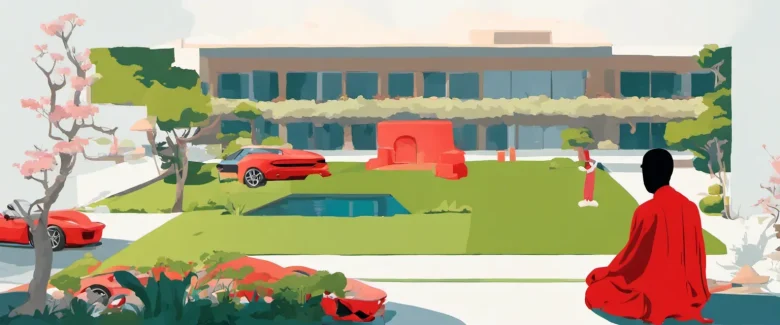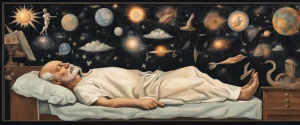In “The Monk Who Sold His Ferrari” by Robin Sharma, the reader embarks on a profound journey of personal transformation and enlightenment. This compelling novel introduces us to Julian Mantle, a high-profile lawyer whose life takes an unexpected turn when he suffers a near-fatal heart attack. Following this wake-up call, Julian embarks on a spiritual quest in search of true happiness, wisdom, and purpose. Authored by Robin Sharma, a globally renowned motivational speaker and leadership expert, this book blends Eastern philosophy, practical wisdom, and captivating storytelling to illuminate the path to a fulfilling and enlightened life.
Chapter 1: The Ferrari
Chapter 1: The Ferrari of “The Monk Who Sold His Ferrari” by Robin Sharma introduces us to the central character, Julian Mantle, a highly successful and prominent lawyer who had it all – fame, wealth, and material possessions. He was often referred to as “the epitome of success.”
However, despite outward success, Julian was living an unfulfilled and miserable life. The excessive stress, constant chase for success, and neglect of his health had taken a toll on him. One fateful day, he suffered a massive heart attack during a high-profile courtroom session, a wake-up call that forced him to reevaluate his priorities and seek a more meaningful existence.
After this life-altering event, Julian vanished from society, leaving behind his luxurious lifestyle, including his prized possession, a shiny red Ferrari. Word spread that he had retreated to the distant Himalayan mountains, in search of purpose and enlightenment.
The chapter introduces the reader to John, Julian’s former colleague and friend, who connects with him after almost three years of no contact. They decide to meet in what appears to be an abandoned garden in the city. As John enters the garden, he is taken aback by the transformation that Julian has undergone. Julian stands before him, now a serene, enlightened, and radiant figure, dressed in a simple robe.
In their conversation, Julian describes his journey from a life of unfulfillment to one of inner peace. He shares with John the principles that guided his transformation, promising to reveal these secrets in subsequent meetings. These teachings revolve around concepts such as “The Seven Virtues of Enlightened Learning” and “The Ten Rituals of Radiant Living.”
John is captivated by Julian’s transformation and wisdom. Although initially skeptical, he agrees to meet Julian again to learn and apply these invaluable life lessons.
Chapter 1 sets the stage for the transformative journey that lies ahead, leaving readers eager to discover the secrets that allowed Julian to leave behind material wealth and find true happiness and contentment.
Chapter 2: The Sudden Collapse
Chapter 2 of “The Monk Who Sold His Ferrari” by Robin Sharma is titled “The Sudden Collapse.” This chapter continues the story of Julian Mantle, a successful lawyer who experienced a life-altering event that led him on a spiritual journey.
The chapter opens with Julian having a heart attack during a successful court case. His near-death experience forces him to confront the imbalance and emptiness in his life. Following his heart attack, Julian spends several weeks in the hospital, reflecting on his choices and the pursuit of material wealth.
With his physical health deteriorating, Julian realizes that he must make a change. He sells all his luxurious possessions, including his Ferrari, and embarks on a quest to find meaning and fulfillment.
The author emphasizes the metaphorical significance of the Ferrari as a symbol of superficial success and how it ultimately contributed to Julian’s collapse. By selling his Ferrari, Julian takes the first step towards a simpler and more meaningful life.
During his recovery, Julian meets a wise Indian mystic named Yogi Raman. They form a deep bond, and Yogi Raman becomes Julian’s mentor and guide. He introduces Julian to a mystical system called the “Seven Virtues of Enlightened Learning,” which promises to transform his life.
Overall, Chapter 2 of “The Monk Who Sold His Ferrari” portrays a pivotal moment in Julian’s life as he faces a sudden physical collapse and an awakening to the emptiness of his materialistic pursuits. The chapter sets the stage for Julian’s journey into spirituality and self-discovery, with Yogi Raman serving as his guide along the way.
Chapter 3: A Remarkable Meeting
In Chapter 3 of “The Monk Who Sold His Ferrari” by Robin Sharma, the protagonist and successful lawyer, Julian Mantle, accepts an invitation to meet with the Sages of Sivana, a community of wise and enlightened individuals. The chapter begins with Julian embarking on a journey to an ancient temple deep within the Himalayas, where the Sages reside.
Upon arriving at the temple, Julian is left in awe at the surroundings and the divinity of the place. He is warmly welcomed and encounters a magnificent character named Yogi Raman, an advanced sage who possesses astonishing levels of knowledge and wisdom. Yogi Raman explains that the Sages have long been waiting for Julian, as they believe he has been seeking answers to life’s fundamental questions.
During their conversation, Yogi Raman imparts numerous pearls of wisdom to Julian, urging him to question his motives and priorities in life. Yogi Raman shares the philosophy of “Fulfillment,” emphasizing the importance of living in the present moment and finding joy in simple experiences. He encourages Julian to detach himself from the materialistic world and find real meaning by focusing on personal growth, relationships, and spirituality.
As the chapter progresses, Yogi Raman introduces Julian to the concept of the “Socratic Discipline of Reflection.” This practice involves self-reflection through writing a daily journal, which would enable Julian to explore his thoughts, feelings, and experiences and gain insight into his life’s purpose.
Overwhelmed by the profundity of their meeting, Julian realizes that the wisdom he has gained through this remarkable encounter will transform his life forever. He expresses gratitude for this life-changing experience and commits to implementing the lessons learned from the Sages of Sivana, setting the stage for personal transformation and self-discovery that lies ahead.
Chapter 4: The Ancient Wisdom

Chapter 4 of “The Monk Who Sold His Ferrari” by Robin Sharma focuses on the importance of living in the present moment and finding happiness within ourselves. In this chapter, the main character, Julian Mantle, continues to share his journey of transformation with his former colleague, John.
Julian explains that he learned the concept of the present moment from the sages of Sivana, a fictional place symbolizing enlightenment. He tells John about the power of mindfulness and living in the now, emphasizing that dwelling on the past or worrying about the future only robs us of our happiness.
To illustrate his point, Julian presents an analogy of the garden. He explains that just as a beautiful garden requires constant care and attention, our minds must also be nurtured in order to experience true joy. He emphasizes the importance of practicing gratitude, self-discipline, and mindfulness in each moment.
Julian then introduces John to the concept of the “Ten Rituals of Radiant Living.” These rituals include practices such as rising early, exercising regularly, and spending time in nature. Julian explains how incorporating these rituals into our lives can help us achieve greater peace and contentment.
The chapter ends with Julian challenging John to implement these rituals and commit to living in the present moment. He believes that by doing so, John will discover a newfound sense of happiness and fulfillment in his life.
In summary, Chapter 4 of “The Monk Who Sold His Ferrari” focuses on the ancient wisdom of living in the present moment. Julian introduces John to the concept of mindfulness, shares the analogy of the garden to emphasize nurturing the mind, and discusses the Ten Rituals of Radiant Living. The chapter encourages readers to prioritize the present, practice gratitude, and adopt daily rituals that promote well-being and happiness.
Chapter 5: The Miraculous Transformation
Chapter 5: The Miraculous Transformation from the book “The Monk Who Sold His Ferrari” by Robin Sharma revolves around the lead character, Julian Mantle, and his profound personal journey towards self-healing and transformation. This chapter serves as a turning point for Julian as he encounters the tragic consequences of his neglect for his own well-being.
The chapter begins with Julian experiencing a heart attack during a particularly high-stress meeting. Rushed to the hospital, he wakes up to find his old friend and apprentice, John, by his side. Recognizing the gravity of his situation, Julian decides to take control of his life and embark on a mission to discover true happiness and fulfillment.
John introduces Julian to the concept of ‘Sages of Sivana’ – ancient mystical gurus who hold the keys to enlightenment and inner peace. Intrigued by the possibility of transformation, Julian agrees to travel with John to India in pursuit of these sages.
Upon reaching India, Julian and John find themselves in a remote village, where they are greeted by the Sages of Sivana. The sages put Julian through a series of challenging tests and teachings, with the intention of enabling him to regain control over his thoughts and emotions.
Throughout the chapter, Julian learns valuable lessons from the sages, including the importance of silence, self-discipline, and self-care. Through meditation and various mindfulness exercises, Julian begins to let go of his ego and discovers the true essence of life.
As the chapter concludes, Julian experiences a miraculous transformation. He becomes a shining example of rejuvenation and personal growth, freeing himself from fear, stress, and discontent. Julian shares his newfound wisdom with John, promising to guide him on his own journey towards personal transformation.
In Chapter 5, “The Miraculous Transformation,” Robin Sharma takes the reader on a captivating journey through Julian’s self-realization and sets the stage for the future lessons and adventures awaiting him.
Chapter 6: The Timeless Secrets
Chapter 6 of “The Monk Who Sold His Ferrari” by Robin Sharma is titled “The Timeless Secrets.” This chapter explores the importance of time management and the secrets to unlocking a fulfilling and purposeful life.
The chapter begins with the author sharing a fable about a successful executive named Sir John. Sir John had achieved both financial wealth and professional success but felt an emptiness deep within. One day, he meets a wise sage who reveals to him the secrets of time. The sage instructs Sir John to take a quiet moment each day to reflect on whether his activities align with his highest values and if they contribute to his ultimate vision for life.
The chapter goes on to discuss the concept of “time mastery,” which involves taking control of one’s schedule and eliminating time-wasting activities. Sharma emphasizes the importance of setting clear goals and determining one’s priorities to make the most of every moment.
Furthermore, the author introduces the “Ten Rituals of Radiant Living,” a set of daily activities designed to nourish the mind, body, and spirit. These rituals include rising early, doing inner reflections, exercising, reading uplifting materials, and spending quality time with loved ones. Sharma argues that incorporating these rituals into one’s life can lead to a deeper sense of fulfillment and purpose.
To make the most of one’s time and live a more meaningful life, Sharma suggests the practice of “S.A.V.E.R.S.” Each letter stands for a specific ritual: Silence (meditation or prayer), Affirmations (positive self-talk), Visualization (creating a mental image of goals), Exercise, Reading, and Scribing (journaling).
In summary, Chapter 6 of “The Monk Who Sold His Ferrari” emphasizes the secrets of time mastery and the significance of establishing daily rituals aligned with one’s values. By actively managing time and incorporating specific practices into daily life, one can unlock a more fulfilling and purposeful existence.
Chapter 7: The Garden of the Soul
Chapter 7 of “The Monk Who Sold His Ferrari” by Robin Sharma is titled “The Garden of the Soul.” In this chapter, the author introduces the concept of nurturing one’s soul and finding inner peace.
The chapter opens with Julian, the protagonist, arriving at an incredibly serene garden after a long journey. The garden is described as a paradise, filled with lush greenery and beautiful flowers. Julian is greeted by a wise gardener who explains that the garden symbolizes the human soul and its need for constant care and attention.
The gardener emphasizes the importance of cultivating positive thoughts and purging negative ones. He compares the weeds in the garden to negative thoughts that can hinder personal growth and happiness. Julian is encouraged to remove these mental weeds by practicing daily rituals of mindfulness, gratitude, and reflection.
The gardener also advises Julian to focus on his intentions and align his actions with his values. By being conscious of his choices and ensuring they resonate with his core beliefs, Julian can lead a more purposeful and fulfilling life.
The chapter concludes with the gardener teaching Julian the power of forgiveness and letting go of past grievances. He explains that harboring anger and resentment prevents one from experiencing true joy and inner peace.
In summary, Chapter 7 of “The Monk Who Sold His Ferrari” explores the importance of tending to one’s soul by adopting positive thoughts, aligning actions with values, and practicing forgiveness. It reinforces the idea that nurturing one’s inner garden is key to finding true happiness and fulfillment in life.

Chapter 8: The Successor
Chapter 8: The Successor of the book “The Monk Who Sold His Ferrari” by Robin Sharma brings forth the story of Jonathan, a young attorney seeking guidance from Julian Mantle, the protagonist of the book. Jonathan, disillusioned with his high-stress career and unfulfilling life, visits Julian at his Himalayan retreat to seek wisdom and find a new purpose.
Throughout the chapter, Julian shares with Jonathan the importance of cultivating deep self-awareness and understanding one’s true purpose in life. Jonathan learns that success and happiness are not solely derived from external accomplishments, but from inner fulfillment and the pursuit of one’s passions.
Julian teaches Jonathan the concept of the “Heart of Leadership” by identifying and working on the four pillars of personal excellence: physical fitness, mental mastery, purposeful relationships, and a meaningful life purpose. He emphasizes the significance of a balanced life, suggesting that success does not require sacrificing health, relationships, or personal well-being.
Furthermore, Julian introduces Jonathan to the idea of being a “Garden of the Mind.” He emphasizes that just as a garden needs constant care and nurturing, our minds require the same attention. By cultivating positive thoughts, eliminating negative influences, and feeding our minds with knowledge, we can create a fertile ground for personal growth and success.
As Jonathan absorbs these teachings, he realizes that his true calling lies in inspiring and guiding others towards a more meaningful and fulfilling life. He sees himself as a successor to Julian, embracing the responsibility of spreading these transformative principles with the rest of the world.
Chapter 8 serves as a turning point for Jonathan, as he starts his own journey towards self-discovery and personal transformation. He returns to his former life with a newfound sense of purpose and a commitment to live a life of authentic success based on inner fulfillment and happiness.
After Reading
In conclusion, “The Monk Who Sold His Ferrari” by Robin Sharma is a thought-provoking and inspiring book that offers valuable lessons on finding true happiness, purpose, and fulfillment in life. Through the journey of Julian Mantle, a successful lawyer who chooses to leave behind his materialistic lifestyle and becomes a monk, Sharma explores the importance of prioritizing personal growth, self-discovery, and leading a more balanced life. By weaving together Eastern philosophy, practical techniques, and captivating storytelling, the book emphasizes the significance of embracing mindfulness, discipline, and living in the present moment. Ultimately, “The Monk Who Sold His Ferrari” encourages readers to embark on a journey of self-transformation, seeking wisdom and happiness beyond material wealth.
1. Quiet: The Power of Introverts in a World That Can’t Stop Talking” by Susan Cain
If you enjoyed “Bittersweet” by Susan Cain, you will definitely appreciate her first book, “Quiet.” In this thought-provoking work, Cain explores the valuable contributions that introverts bring to society and challenges the prevailing belief that extroversion is always preferable. This compelling read offers invaluable insights into introversion and offers practical strategies for both introverts and extroverts to navigate the world with greater understanding and empathy.
2. “Dare to Lead: Brave Work. Tough Conversations. Whole Hearts.” by Brené Brown
Building on the themes of effective communication and leadership explored in “Radical Candor,” “Dare to Lead” by Brené Brown is an inspiring and insightful book that encourages readers to embrace vulnerability and authenticity in their professional lives. With research-backed advice and captivating stories, Brown explores how cultivating empathy and demonstrating courage can transform individuals and organizations. This book is a must-read for anyone looking to enhance their leadership skills and build strong, connected teams.
3. “Big Magic: Creative Living Beyond Fear” by Elizabeth Gilbert
In “The Artist’s Way,” Julia Cameron provides guidance and inspiration for artistic creativity. For a similar but slightly different approach, “Big Magic” by Elizabeth Gilbert is a delightful exploration of living a creative life. Gilbert shares her personal experiences and philosophies about the nature of creativity, offering practical advice and encouraging readers to follow their passions fearlessly. This book will awaken your creative spirit and empower you to embrace a more courageous and fulfilling existence.
4. The Power of Now: A Guide to Spiritual Enlightenment” by Eckhart Tolle
If “The Monk Who Sold His Ferrari” resonated with you and left you seeking spiritual and personal growth, “The Power of Now” by Eckhart Tolle is the perfect next read. In this transformative book, Tolle discusses the importance of being present and fully engaged, emphasizing the power of living in the present moment. Through simple yet profound teachings, he guides readers towards finding inner peace, discovering their true selves, and enhancing their overall well-being.
5. Atomic Habits: An Easy & Proven Way to Build Good Habits & Break Bad Ones” by James Clear
To complement the lessons on self-improvement and personal transformation offered by “The Monk Who Sold His Ferrari,” “Atomic Habits” by James Clear presents actionable strategies for building lasting habits. Clear breaks down the science behind habit formation and provides practical techniques to help readers make small, incremental changes that lead to remarkable results. This thought-provoking book will teach you how to reshape your habits and create a positive ripple effect throughout various areas of your life.



